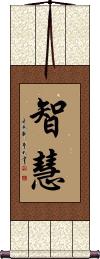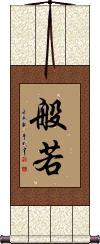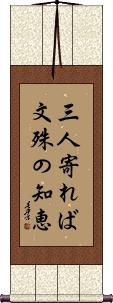Many custom options...
And formats...

Prajna in Chinese / Japanese...
Buy a Prajna calligraphy wall scroll here!
Personalize your custom “Prajna” project by clicking the button next to your favorite “Prajna” title below...
Wisdom
(All-Knowing)
Beyond wisdom, 智慧 can be translated as knowledge, sagacity, sense, and intelligence.
The first character means “wise” or “smart,” and the second character means “intelligence.”
Note: 智慧 is used commonly in Chinese and is a less-common word in Japanese and Korean. If your audience is Japanese, I suggest our other Japanese wisdom option.
This means intellect or wisdom in Japanese too but is a more unusual way to write this word (though both versions are pronounced the same in Japanese).
See Also: Learn From Wisdom
Great Wisdom
Prajñā
般若 means great wisdom or wondrous knowledge.
In the Buddhist context, this is prajna or prajñā, to know, to understand, to have the wisdom required to attain enlightenment.
Since this is a wisdom that transcends the realm of logic, the pure, absolute wisdom beyond the reach of words and concepts, it is not obtained through learning but is realized for the first time through a religious experience.
Wisdom / Intelligence
When Three People Gather, Wisdom is Multiplied
三人寄れば文殊の知恵 literally means “when three people meet, wisdom is exchanged.”
Some will suggest this means when three people come together, their wisdom is multiplied.
That wisdom part can also be translated as wit, sagacity, intelligence, or Buddhist Prajna (insight leading to enlightenment).
In the middle of this proverb is “monju,” suggesting “transcendent wisdom.” This is where the multiplication of wisdom ideas comes from.
Note: This is very similar to the Chinese proverb, "When 3 people meet, one becomes a teacher."
Note: Because this selection contains some special Japanese Hiragana characters, it should be written by a Japanese calligrapher.
Not the results for prajna that you were looking for?
Below are some entries from our dictionary that may match your prajna search...
| Characters If shown, 2nd row is Simp. Chinese |
Pronunciation Romanization |
Simple Dictionary Definition |
慧 see styles |
huì hui4 hui megumi めぐみ |
More info & calligraphy: Wisdom / Intelligence(1) wisdom; enlightenment; (2) (Buddhist term) prajna (one of the three divisions of the noble eightfold path); wisdom; (female given name) Megumi prajñā ; sometimes jñāna. Wisdom, discernment, understanding; the power to discern things and their underlying principles and to decide the doubtful. It is often interchanged with 智, though not correctly, for zhi means knowledge, the science of the phenomenal, while hui refers more generally to principles or morals. It is part of the name of many monks, e.g. 慧可 Huike; 慧思Huisi. |
智恵 see styles |
norie のりえ |
More info & calligraphy: Wisdom / Intelligence |
智慧 see styles |
zhì huì zhi4 hui4 chih hui tomoe ともえ |
More info & calligraphy: Wisdom(1) wisdom; wit; sagacity; sense; intelligence; (2) (Buddhist term) prajna (insight leading to enlightenment); (female given name) Tomoe jñāna as 智 knowledge and prajñā as 慧 discernment, i.e. knowledge of things and realization of truth; in general knowledge and wisdom; but sometimes implying mental and moral wisdom. |
知恵 see styles |
tomoe ともえ |
More info & calligraphy: Wisdom |
般若 see styles |
bō rě bo1 re3 po je hannya はんにゃ |
More info & calligraphy: Great Wisdom(1) {Buddh} prajna (wisdom required to attain enlightenment); (2) {noh} (See 般若面・1) hannya; mask of a grinning, horned demoness (represents a woman's rage and jealousy); (3) (abbreviation) (See 般若面・2) dreadful face (esp. of a woman driven mad by jealousy); terrifying facial expression; (surname) Hanniya (般賴若) Prajñā is also the name of a monk from Kabul, A.D. 810, styled 三藏法師; tr. four works and author of an alphabet.; prajñā, 'to know, understand'; 'Wisdom. ' M. W. Intp. 慧 wisdom; 智慧 understanding, or wisdom; 明 clear, intelligent, the sixth pāramitā. The Prajñā-pāramitā Sutra describes it as supreme, highest, incomparable, unequalled, unsurpassed. It is spoken of as the principal means, by its enlightenment, of attaining to nirvana, through its revelation of the unreality of all things. Other forms 般羅若; 般諄若; 鉢若; 鉢剌若; 鉢羅枳孃; 鉢腎禳; 波若, 波賴若; 波羅孃; 班若. |
恵 see styles |
huì hui4 hui meguru めぐる |
Japanese variant of 惠[hui4] (1) wisdom; enlightenment; (2) (Buddhist term) prajna (one of the three divisions of the noble eightfold path); wisdom; (female given name) Meguru |
槃若 see styles |
pán ruò pan2 ruo4 p`an jo pan jo hannya |
prajñā |
波若 see styles |
bō ruò bo1 ruo4 po jo namiwaka なみわか |
(surname) Namiwaka prajñā |
鉢若 钵若 see styles |
bō ruò bo1 ruo4 po jo hanya |
prajñā |
三般若 see styles |
sān bō rě san1 bo1 re3 san po je san hannya |
The three prajñās, or perfect enlightenments: (a) 實相般若 wisdom in its essence or reality; (b) 觀照般若 the wisdom of perceiving the real meaning of the last; (c) 方便般若 or 文字般若 the wisdom of knowing things in their temporary and changing condition. |
定慧社 see styles |
dìng huì shè ding4 hui4 she4 ting hui she Jōesha |
samādhi and prajñā society |
小品經 小品经 see styles |
xiǎo pǐn jīng xiao3 pin3 jing1 hsiao p`in ching hsiao pin ching Shōbon kyō |
shorter version of the Mahā-prajñā-pāramitā-sūtra |
Variations: |
e え |
(1) wisdom; enlightenment; (2) {Buddh} (See 三学) prajñā (one of the three divisions of the noble eightfold path); wisdom |
波若論 波若论 see styles |
bō ruò lùn bo1 ruo4 lun4 po jo lun Hanya ron |
Prajñā Treatise |
般若德 see styles |
bō rě dé bo1 re3 de2 po je te hannya no toku |
attribute of prajñā |
般若時 般若时 see styles |
bō rě shí bo1 re3 shi2 po je shih hannya ji |
The prajñā period, the fourth of the (Tiantai) five periods of the Buddha's teaching. |
般若部 see styles |
bō rě bù bo1 re3 bu4 po je pu hannya bu |
prajñā section |
般若頭 般若头 see styles |
bō rě tóu bo1 re3 tou2 po je t`ou po je tou hannya jū |
The monk in charge of the prajñā sutras. |
鉢羅若 钵罗若 see styles |
bō luó ruò bo1 luo2 ruo4 po lo jo haranya |
v. 般 prajñā. |
大智度論 大智度论 see styles |
dà zhì dù lùn da4 zhi4 du4 lun4 ta chih tu lun Dai chido ron |
A śāstra ascribed to Nāgārjuna on the greater Prajna-paramita sutra; the sastra was tr. by Kumārajīva, A.D. 397―415, in 100 chuan. |
文字般若 see styles |
wén zì bō rě wen2 zi4 bo1 re3 wen tzu po je moji hannya |
prajñā that relies on words |
般若三昧 see styles |
bō rě sān mèi bo1 re3 san1 mei4 po je san mei hannya zanmai |
prajñā-samādhi |
般若威力 see styles |
bō rě wēi lì bo1 re3 wei1 li4 po je wei li hannyairiki |
the power of prajñā |
般若菩薩 般若菩萨 see styles |
bō rě pú sà bo1 re3 pu2 sa4 po je p`u sa po je pu sa Hannya Bosatsu |
Prajñā-bodhisattva; wisdom as a female bodhisattva in the garbhadhātu group; also known as 智慧金剛. |
觀照般若 观照般若 see styles |
guān zhào bō rě guan1 zhao4 bo1 re3 kuan chao po je kanshō hannya |
The prajñā or wisdom of meditative enlightenment on reality. |
鉢羅枳孃 钵罗枳孃 see styles |
bō luó zhǐ niáng bo1 luo2 zhi3 niang2 po lo chih niang harakina |
鉢羅賢禳 v. 般 prajñā. |
鉢羅賢禳 钵罗贤禳 see styles |
bō luó xián ráng bo1 luo2 xian2 rang2 po lo hsien jang harakenjō |
(Skt. prajñā) |
五同緣意識 五同缘意识 see styles |
wǔ tóng yuán yì shì wu3 tong2 yuan2 yi4 shi4 wu t`ung yüan i shih wu tung yüan i shih go dōen ishiki |
One of the four kinds of 意識 q. v.; the mental concept of the perceptions of the five senses. 五味 The five flavours, or stages of making ghee, which is said to be a cure for all ailments; it is a Tiantai illustration of the five periods of the Buddha's teaching: (1) M000190 |ksira, fresh milk, his first preaching, i. e. that of the 華嚴經 Avatamsaka, for śrāvakas and pratyeka-buddhas; (2) 酪 |dadhi, coagulated milk, cream, the 阿含經 Agamas, for Hīnayāna generally; (3) 生酥 | navanita, curdled, the 方等經 Vaipulyas, for the Mahāyāna 通經(4) 涅槃經 |ghola, butter, the 般若經 Prajna, for the Mahāyāna 別教; (5) 醍醐 |sarpirmandla, clarified butter, ghee, the 法華 Lotus and 涅槃經 Nirvana sutras, for the Mahāyāna 圓教; see also 五時教, and v. 涅槃經 14. Also, the ordinary five flavours -sour, bitter, sweet, pungent, and salty. |
般若波羅密 般若波罗密 see styles |
bō rě bō luó mì bo1 re3 bo1 luo2 mi4 po je po lo mi |
prajña paramita (Sanskrit: supreme wisdom - beginning of the Heart Sutra) |
般若波羅蜜 般若波罗蜜 see styles |
bō rě bō luó mì bo1 re3 bo1 luo2 mi4 po je po lo mi hannyaharamitsu はんにゃはらみつ |
{Buddh} prajna-paramita (perfection of wisdom) (般若波羅蜜多) prajñā-pāramitā, The acme of wisdom, enabling one to reach the other shore, i.e. wisdom for salvation; the highest of the six paramitas, the virtue of wisdom as the notes a knowledge of the illusory character of everything earthly, and destroys error, ignorance, prejudice, and heresy. For the sutra of this name see below. |
Click here for more prajna results from our dictionary
The following table may be helpful for those studying Chinese or Japanese...
| Title | Characters | Romaji (Romanized Japanese) | Various forms of Romanized Chinese | |
| Wisdom | 智慧 | chie | zhì huì / zhi4 hui4 / zhi hui / zhihui | chih hui / chihhui |
| Great Wisdom | 般若 | hannya | bō rě / bo1 re3 / bo re / bore | po je / poje |
| Wisdom Intelligence | 智恵 | chie | ||
| When Three People Gather, Wisdom is Multiplied | 三人寄れば文殊の知恵 | san nin yore ba monju no chie sanninyorebamonjunochie | ||
Successful Chinese Character and Japanese Kanji calligraphy searches within the last few hours...







